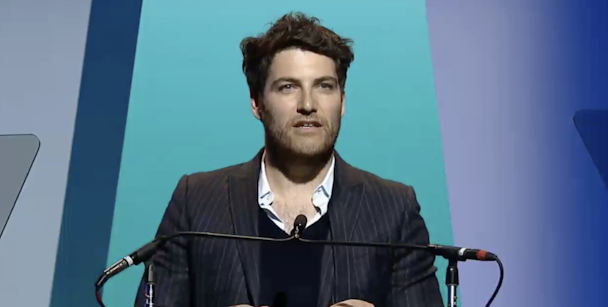Adam Pally just nailed my existential crisis as an advertising creative
“Sometimes people don't want to hear the truth because they don't want their illusions destroyed.” -Frederick Nietzsche

Adam Pally presenting at the Shorty Awards earlier this month
Social media has an awards show, and Adam Pally still can’t accept it. Two Sundays ago, the actor known for his roles on “Happy Endings” and “The Mindy Project” got kicked offstage in a four-alarm blaze of glory while presenting at a social media awards show. And he got paid for it.
Mr. Pally went on an 11 minute or so rail against the creators, influencers and brands of the internet at the “DMV of award shows,” as he put it, more popularly known as the Shorty Awards. It has now been taken off the internet.
He knew what he was getting into. No one forced him to present an award he didn’t believe in at an award show he didn’t buy into. He signed a contract, got on a plane, thought about showering and put on his (not-so) finest suit to present a “glass vagina” (his words) to a...company.
While it would be easy to cast Mr. Pally off as an aging*, out-of-touch, unfunny hater who probably was surprised to see that AIM no longer exists during the “In Memoriam” section and had one too many Mich Goldens before taking the stage, the content of his rant deserves further analysis, as it pretty much sums up the existential crisis I’m facing as a creative in the advertising industry today.
What is going on?
Where are we?
Why are people getting awards?
Am I going to get an award?
What qualifies you to get an award?
I have been a professional creative for 15 years. I was brought up in a world where the grand puba of creative excellence was the 60-second broadcast commercial. And if you made a 60-second commercial that didn’t look like a commercial you called it a “film” and you may get your “film” recognized at a festival in the South of France that’s better known for celebrating actual films.
And then there was the LaChappellian music video ad era, mostly comprised of liquor brands and the occasional Swagger Wagon. Then came the branded content series. BMW Films. Iconoclasts. Gatorade “Replay.” Advertising that rolled out in episodes like television shows that made you forget who was behind them. All highly awarded. And lest we forget the Boguskian age celebrating brands that flipped traditional ad media on its head: “What if the commercial was 2 minutes long? 15 minutes long? 1 second long? What if the billboard had no copy? Long copy? Consecutive billboards? What if someone lived on a billboard? What if we did consecutive thirds in the magazine? What if we bought out the magazine? What if we did something unique with the spine? What if we did something crazy with a guy dressed in a chicken suit and HTML5?”
Advertising has a rich history of thinking bigger than itself because of our firmly ingrained cultural belief that no one likes ads (except all of our friends and family who point out the ads they saw the other day wondering if we did them). It’s no wonder, then, that our most awarded advertising has been “non-advertising.”
So, what is our “non-advertising” bar of excellence in the bite-sized social media era? How do we award brands when we don’t really need a jury to judge them (we can just check the comments)?
We’re no longer aiming to break through but rather fit in. Our creative benchmarks don’t have us thinking bigger but much, much, much smaller: sponsored posts, Twitter back-and-forths, “homemade” viral videos, ads directed at one person at one time, an ad reacting to another ad that’s reacting to a pop culture moment that’s happening right now, #jointheconversation. Brands are now in a race for first instead of battle for best, tapping into personal info to sell us to ourselves. Remember the Tinder profile for Ex Machina? Or the Netflix “Christmas Prince” controversy? Or the Cost Plus World Market billboards written directly to customers near their homes? All award winning. All created because we can. But should we?
Like most of us, I’m in those big data meetings where people talk about new ways to get “hyper targeted” and “more personalized” for our clients to be “more real-time and relevant” to our audiences. We are awarding our use of applied science to fit into our culture more than we are awarding the art of fascination to advance it.
Everyone knows that brands mixing in with people on social media blurs the lines between real, honest, in-the-moment connection and a highly strategized sales pitch. But herein lies my question-slash-existential crisis: when we start to award brands for essentially pretending to be us, what does that say about us? And more importantly, do we care?
What is going on?
Where are we?
Why are people getting awards?
Am I going to get an award?
What qualifies you to get an award?
Are we judging advertising anymore, or are we just judging ourselves?
(*N.B. Adam Pally is 36 years old. By Wikipedia definition, that makes him technically a millennial and legally required to love the internet.)
Paula Maki is managing creative director at Mono SF. She tweets @paulamaki

